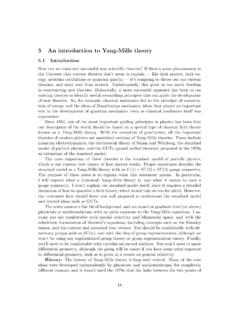Transcription of Quantum Computation and Quantum Information
1 Quantum Computation and Quantum Information Michael A. Nielsen & Isaac L. Chuang PUBLISHED BY THE PRESS SYNDICATE OF THE UNIVERSITY OF CAMBRIDGE. The Pitt Building, Trumpington Street, Cambridge, United Kingdom CAMBRIDGE UNIVERSITY PRESS. The Edinburgh Building, Cambridge CB2 2RU, UK 40 West 20th Street, New York, NY 10011-4211, USA 10 Stamford Road, Oakleigh, Melbourne 3166, Australia Ruiz de Alarc on 13, 28014 Madrid, Spain . c Cambridge University Press 2000. This book is in copyright. Subject to statutory exception and to the provisions of relevant collective licensing agreements, no reproduction of any part may take place without the written permission of Cambridge University Press.
2 First published 2000. Printed in the United Kingdom at the University Press, Cambridge Typeface Monotype Ehrhardt 10 12 /13pt System LATEX 2 [EPC]. A catalogue record of this book is available from the British Library Library of Congress Cataloguing in Publication data Nielsen, Michael A., and Chuang, Isaac L. Quantum Computation and Quantum Information / Michael A. Nielsen and Isaac L. Chuang. p. cm. Includes bibliographical references and index. ISBN 0-521-63503-9. 1. Physics. I. Title. 2000. 5110 .8 dc21 98-22029 CIP. ISBN 0 521 63235 8 hardback ISBN 0 521 63503 9 paperback Contents Preface page xv Acknowledgements xxi Nomenclature and notation xxiii Part I Fundamental concepts 1.
3 1 Introduction and overview 1. Global perspectives 1. History of Quantum Computation and Quantum Information 2. Future directions 12. Quantum bits 13. Multiple qubits 16. Quantum Computation 17. Single qubit gates 17. Multiple qubit gates 20. Measurements in bases other than the computational basis 22. Quantum circuits 22. Qubit copying circuit? 24. Example: Bell states 25. Example: Quantum teleportation 26. Quantum algorithms 28. Classical computations on a Quantum computer 29. Quantum parallelism 30. Deutsch's algorithm 32. The Deutsch Jozsa algorithm 34. Quantum algorithms summarized 36. Experimental Quantum Information processing 42.
4 The Stern Gerlach experiment 43. Prospects for practical Quantum Information processing 46. Quantum Information 50. Quantum Information theory: example problems 52. Quantum Information in a wider context 58. 2 Introduction to Quantum mechanics 60. Linear algebra 61. Bases and linear independence 62. Linear operators and matrices 63. viii Contents The Pauli matrices 65. Inner products 65. Eigenvectors and eigenvalues 68. Adjoints and Hermitian operators 69. Tensor products 71. Operator functions 75. The commutator and anti-commutator 76. The polar and singular value decompositions 78. The postulates of Quantum mechanics 80.
5 State space 80. Evolution 81. Quantum measurement 84. Distinguishing Quantum states 86. Projective measurements 87. POVM measurements 90. Phase 93. Composite systems 93. Quantum mechanics: a global view 96. Application: superdense coding 97. The density operator 98. Ensembles of Quantum states 99. General properties of the density operator 101. The reduced density operator 105. The Schmidt decomposition and purifications 109. EPR and the Bell inequality 111. 3 Introduction to computer science 120. Models for Computation 122. Turing machines 122. Circuits 129. The analysis of computational problems 135. How to quantify computational resources 136.
6 Computational complexity 138. Decision problems and the complexity classes P and NP 141. A plethora of complexity classes 150. Energy and Computation 153. Perspectives on computer science 161. Part II Quantum Computation 171. 4 Quantum circuits 171. Quantum algorithms 172. Single qubit operations 174. Controlled operations 177. Measurement 185. Universal Quantum gates 188. Contents ix Two-level unitary gates are universal 189. Single qubit and cnot gates are universal 191. A discrete set of universal operations 194. Approximating arbitrary unitary gates is generically hard 198. Quantum computational complexity 200.
7 Summary of the Quantum circuit model of Computation 202. Simulation of Quantum systems 204. Simulation in action 204. The Quantum simulation algorithm 206. An illustrative example 209. Perspectives on Quantum simulation 211. 5 The Quantum Fourier transform and its applications 216. The Quantum Fourier transform 217. Phase estimation 221. Performance and requirements 223. Applications: order-finding and factoring 226. Application: order-finding 226. Application: factoring 232. General applications of the Quantum Fourier transform 234. Period-finding 236. Discrete logarithms 238. The hidden subgroup problem 240. Other Quantum algorithms?
8 242. 6 Quantum search algorithms 248. The Quantum search algorithm 248. The oracle 248. The procedure 250. Geometric visualization 252. Performance 253. Quantum search as a Quantum simulation 255. Quantum counting 261. Speeding up the solution of NP-complete problems 263. Quantum search of an unstructured database 265. Optimality of the search algorithm 269. Black box algorithm limits 271. 7 Quantum computers: physical realization 277. Guiding principles 277. Conditions for Quantum Computation 279. Representation of Quantum Information 279. Performance of unitary transformations 281. Preparation of fiducial initial states 281.
9 Measurement of output result 282. Harmonic oscillator Quantum computer 283. Physical apparatus 283. x Contents The Hamiltonian 284. Quantum Computation 286. Drawbacks 286. Optical photon Quantum computer 287. Physical apparatus 287. Quantum Computation 290. Drawbacks 296. Optical cavity Quantum electrodynamics 297. Physical apparatus 298. The Hamiltonian 300. Single-photon single-atom absorption and refraction 303. Quantum Computation 306. Ion traps 309. Physical apparatus 309. The Hamiltonian 317. Quantum Computation 319. Experiment 321. Nuclear magnetic resonance 324. Physical apparatus 325. The Hamiltonian 326. Quantum Computation 331.
10 Experiment 336. Other implementation schemes 343. Part III Quantum Information 353. 8 Quantum noise and Quantum operations 353. Classical noise and Markov processes 354. Quantum operations 356. Overview 356. Environments and Quantum operations 357. Operator-sum representation 360. Axiomatic approach to Quantum operations 366. Examples of Quantum noise and Quantum operations 373. Trace and partial trace 374. Geometric picture of single qubit Quantum operations 374. Bit flip and phase flip channels 376. Depolarizing channel 378. Amplitude damping 380. Phase damping 383. Applications of Quantum operations 386. Master equations 386.

